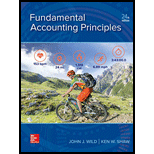
Concept explainers
Concept Introduction:
Sales variance is the difference between budgeted sales and actual sales. Sales variance can be because of two reasons
- Actual selling price of the product varies from the budgeted selling price and/or
- Actual quantity of sales varies from the budgeted quantity.
Therefore, sales variance is the sum of (i) Sales Price Variance and (ii) Sales Volume Variance.
Sales Price Variance:
The difference between the actual selling price and the budgeted selling price is the Sales Price Variance.
Sales Volume Variance:
The difference between actual quantity of sales and budgeted quantity is the Sales Volume Variance.
The following formulas are used to calculate Sales variance:
SalesVariance=Sales Price Variance+ Sales Volume Variance
Also Sales Variance = Budgeted Sales − Actual SalesSales Price Variance = Actual Sales - Actual quantity of Sales at budgeted price
Sales Volume Variance = Actual quantity at budgeted price -Budgeted quantity at budgeted price
Sales variance gives a view of deviations from the set standards which can be wither favorable or unfavorable
Sales Price and Volume Variance
Want to see the full answer?
Check out a sample textbook solution
Chapter 23 Solutions
Fundamental Accounting Principles
- Please provide the answer to this general accounting question using the right approach.arrow_forwardDoom Ltd uses predetermined overhead rates based on labor hours. The monthly budgeted overhead is $470,000 and the budgeted labor hours were 20,000. During the month the company worked a total of 70,000 labor hours and actual overheads totaled $230,000. The overhead at the end of the month would therefore be$? General accounting questionarrow_forwardThe principle of matching costs with revenues is known as _____ principle. a. Cost b. Matching c. Consistency d. Revenuearrow_forward
- Doom Ltd uses predetermined overhead rates based on labor hours. The monthly budgeted overhead is $470,000 and the budgeted labor hours were 20,000. During the month the company worked a total of 70,000 labor hours and actual overheads totaled $230,000. The overhead at the end of the month would therefore be$?arrow_forwardI am trying to find the accurate solution to this general accounting problem with appropriate explanations.arrow_forwardThe main function of cost accounting is _______ reporting a. Internal b. External c. Government d. Bankarrow_forward
- Direct materials cost is Rs. 80,000. Direct labor cost is Rs. 60,000. Factory overhead is Rs. 90,000. Beginning goods in process were Rs. 15,000. The cost of goods manufactured is Rs. 245,000. What is the cost assigned to the ending goods in process?arrow_forwardHarris Company assigns overhead cost to jobs on the basis of 120% of direct labor cost. The job cost sheet for Job 205 includes $18,500 in direct materials cost and $15,200 in direct labor cost. A total of 2,300 units were produced in Job 205. Required: a. What is the total manufacturing cost assigned to Job 205? b. What is the unit product cost for Job 205?arrow_forwardWhat is cost accounting? explain its importance.arrow_forward

 AccountingAccountingISBN:9781337272094Author:WARREN, Carl S., Reeve, James M., Duchac, Jonathan E.Publisher:Cengage Learning,
AccountingAccountingISBN:9781337272094Author:WARREN, Carl S., Reeve, James M., Duchac, Jonathan E.Publisher:Cengage Learning, Accounting Information SystemsAccountingISBN:9781337619202Author:Hall, James A.Publisher:Cengage Learning,
Accounting Information SystemsAccountingISBN:9781337619202Author:Hall, James A.Publisher:Cengage Learning, Horngren's Cost Accounting: A Managerial Emphasis...AccountingISBN:9780134475585Author:Srikant M. Datar, Madhav V. RajanPublisher:PEARSON
Horngren's Cost Accounting: A Managerial Emphasis...AccountingISBN:9780134475585Author:Srikant M. Datar, Madhav V. RajanPublisher:PEARSON Intermediate AccountingAccountingISBN:9781259722660Author:J. David Spiceland, Mark W. Nelson, Wayne M ThomasPublisher:McGraw-Hill Education
Intermediate AccountingAccountingISBN:9781259722660Author:J. David Spiceland, Mark W. Nelson, Wayne M ThomasPublisher:McGraw-Hill Education Financial and Managerial AccountingAccountingISBN:9781259726705Author:John J Wild, Ken W. Shaw, Barbara Chiappetta Fundamental Accounting PrinciplesPublisher:McGraw-Hill Education
Financial and Managerial AccountingAccountingISBN:9781259726705Author:John J Wild, Ken W. Shaw, Barbara Chiappetta Fundamental Accounting PrinciplesPublisher:McGraw-Hill Education





